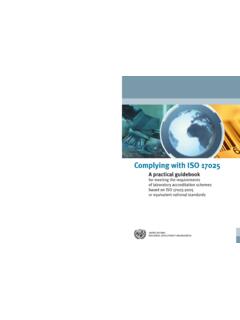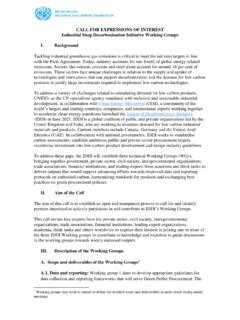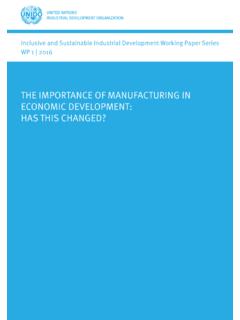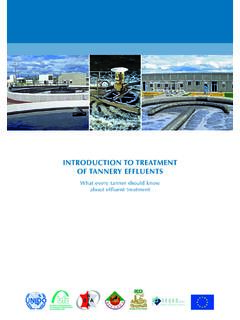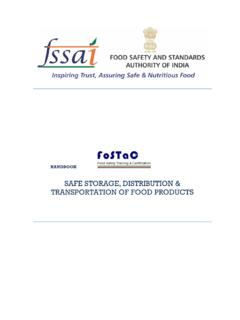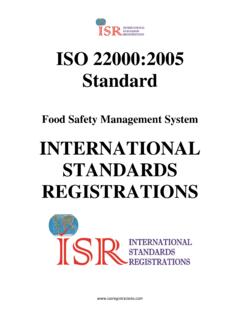Transcription of Small-scale Fruit and Vegetable Processing and Products
1 UNIDO TECHNOLOGY MANUAL. Small-scale Fruit and Vegetable Processing and Products Production methods, equipment and quality assurance practices UNITED NATIONS INDUSTRIAL DEVELOPMENT ORGANIZATION. economy environment employment UNIDO Technology Manual Small-scale Fruit and Vegetable Processing and Products Production Methods, Equipment and Quality Assurance practices UNITED NATIONS INDUSTRIAL DEVELOPMENT ORGANIZATION. Vienna, 2004. Copyright 2004 by the United Nations Industrial Development Organization First published 2004. This manual was prepared by Dr Peter Fellows, UNIDO Consultant, in cooperation with the project team and under the supervision of UNIDO Project Manager: Dr A. Ouaouich. Designations employed and the presentation of material in this publication do not imply the expression of any opinion whatsoever on the part of the Secretariat of the United Nations Industrial Development Organization (UNIDO) concerning the legal status of any country, territory, city or area, or of its authorities, or concerning the delimitation of its frontiers or boundaries.
2 The opinions, figures and estimates set forth are the responsibility of the authors and should not necessarily be considered as reflecting the views or carrying the endorsement of UNIDO. The mention of firm names or commercial Products does not imply endorsement by UNIDO. This document has not been formally edited. 2. Preface UNIDO has emphasized micro/ Small-scale business development it its technical assistance programmes as a means to contribute to economic growth and poverty reduction in Africa in general and Uganda in particular. This technology manual is an important tool that contributes to the capacity building activities carried out by UNIDO in the Small-scale food Processing sector within the framework of the UNIDO Uganda Integrated Programme: Enhanced Competitiveness and Sustainability of Industrial Development - Agro-industries and Micro/ Small-scale Enterprises.
3 The purpose of this manual is to guide Small-scale processors in the Ugandan fruits and vegetables sector to optimize their Processing methods and implement quality assurance schemes and GHP ( good hygienic practices ) and GMP ( good manufacturing practices ). programmes thus building their technical capacity for improved market access and competitiveness. In general, Fruit and Vegetable Processing offers good opportunities for Small-scale businesses in Uganda. This is because: Raw materials are readily available (often in surplus). Most equipment is reasonably affordable and The Products , if chosen correctly, have a good demand and can be profitable. Processing fruits and vegetables is intended to do two things: 1. To preserve them by slowing down the natural processes of decay caused by micro- organisms, enzymes in the food, or other factors such as heat, moisture and sunlight.
4 2. To change them into different foods, which are attractive and in demand by consumers. Like chefs and caterers, processors should use their skills to develop attractive recipes and make Products that consumers want to eat. By doing this successfully, they can increase sales and earn an income. Processors must choose their Products very carefully. It is not enough to assume that Processing can be a successful business simply because there is plenty of cheap Fruit available. There must be a good demand for the processed food and this must be clearly identified before a business is set up. The best types of Products for Small-scale production are those that have a high added-value' as well as a good demand. A high added value means that cheap raw materials can be processed into relatively expensive Products . It also means that this can be done at a small scale of Processing using equipment that is affordable.
5 Small-scale Fruit and Vegetable processors have many competitors in Uganda as well as competing with imported Products . To be profitable, it is therefore essential to have good quality Products , attractive packaging and a well-managed business. To successfully compete, a business should do everything it can to make Products at competitive prices and develop new ones that they are different to those of competitors. This technology manual covers the technical aspects of Fruit and Vegetable Processing but does not deal with the many other aspects of operating a successful small business (such as marketing, business and financial planning and management skills). Institutions listed in Annex A can provide more information on these topics. They are also covered in training courses organised by the Uganda Cottage Scale Food Processors Association (UCOFPA). under the UNIDO Uganda Integrated Programme: Enhanced Competitiveness and Sustainability of Industrial Development - Agro-industries and Micro/Small Scale Enterprises.
6 3. Together with GHP, GMP and proper management, processors (and retailers) should be aware of new laws that are coming in Uganda that relate to food safety. These are based on standards produced by an organisation known as the Codex Alimentarius Commission and they apply internationally. Some manufacturers of processed fruits and vegetables already export their Products from Uganda. In this case Codex standards are already in force and producers should consult with the Bureau of Standards to ensure compliance. The requirements of new food safety laws can be met using good manufacturing and hygienic practices , and a technique known as the Hazard Analysis Critical Control Point (HACCP). system. There procedures will eventually apply to all manufacturers in Uganda, whether they export or not. Details of quality assurance methods that will enable manufacturers to produce safe foods are given in this manual, and further information on HACCP is available from the Bureau of Standards.
7 The facilities needed for commercial Fruit and Vegetable Processing are described in Section 2. Production planning techniques and Processing methods for Fruit and Vegetable Products that are popular in Uganda are described in Sections 3 and 4. Details of the service and maintenance requirements of Processing equipment are given in Section 5. Quality assurance methods are referenced in every section and summarized in Section 6. There is additional information on international and domestic food safety regulations, laws and standards in Section 7. 4. How to use this manual The information contained in this Technology Manual is intended to serve three purposes: 1. It is a resource for trainers who work with small scale Fruit and Vegetable Processing entrepreneurs at Pilot Centres established under the UNIDO Enhanced Competitiveness and Sustainability of Industrial Development - Agro-industries and Micro/Small Scale Enterprises Programme and 2.
8 It is a reference manual to assist these entrepreneurs to continue to improve the technical aspects of their businesses after training. 3. It is a reference manual that outlines practices and procedures for the production of safe, high quality Fruit and Vegetable -based processed Products and for development of good hygienic practices (GHP) and good manufacturing practices (GMP) programmes that will serve as the foundation for the preparation of a Hazard Analysis and Critical Control Point (HACCP) system. Where appropriate, there are worked examples of calculations to assist entrepreneurs to develop their skills, particularly in production planning. Throughout the text there are also checklists of important points to enable processors to assess their present quality and food safety practices . This will assist the processors and producers to identify where production, Processing , hygiene and food safety improvements are needed.
9 5. Contents Page Preface 3. How to use this manual 5. Contents 6. 1 Introduction to Fruit and Vegetable Processing and Products 9. Checklist 1 11. 2 Production Facilities 13. The site 13. The building 13. Roofs and ceilings 14. Walls, windows and doors 14. Floors 15. Services 15. Lighting and power 15. Water supply and sanitation 16. Checklist 2 19. 3 Production Planning 21. Raw materials 22. Packaging 25. Equipment 27. Staff 28. Record-keeping 29. Checklist 3 31. 4 Products and Production Methods Fruits and Vegetables 33. Products that have a high demand 35. Fried Products 35. Dried fruits and vegetables 37. Juices, squashes and cordials 40. Sauces 43. Wines 45. Products that have a lower demand 47. Chutneys 47. Jams, jellies and marmalades 49. Pickles and salted vegetables 53. Pastes and purees 55. Products that may have a future demand 55. Bottled fruits 55.
10 Crystallized fruits, Fruit leathers and Fruit cheese 57. Checklist 4 59. 5 Fruit and Vegetable Processing Equipment 61. Airlocks 64. Blanchers 64. Boiling pans and pasteurizers 64. Bottle coolers 65. Bottle washers 65. Capsule sealer 65. Corers 66. Corkers 66. Cutting boards 66. 6. Deep fat fryers 67. Dicers 67. Dryers 67. Fermentation tanks/food grade drums 68. Fillers/insulated tanks 68. Filters 69. Freezers 69. Fruit crushers 69. Fruit presses 70. Gas burners/cylinders/regulators 71. General tools and tables 71. Heat sealers 71. Hosepipes and spray guns 72. Hydrometers alcohol and brine 72. Jam thermometers 73. Label applicators 73. Laboratory glassware/equipment 73. Liquidisers 73. Motors/isolators/starters 74. Peelers 74. pH meters 74. Pot and bottle sealers/cappers 74. Pressure cookers 74. Protective gloves, hats, hairnets, coats and boots 74. Pulper-finishers 75.

